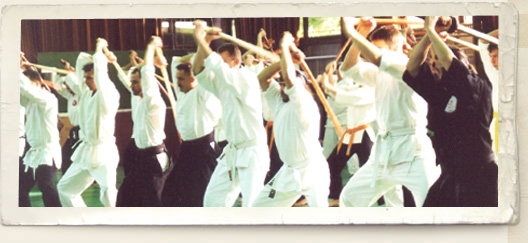
Kiai
At physical layer the Kiai seems to be an exquisite cry which erupts to the surface from the very inside of the practitioner. Not only from his throat. During the Kiai we concentrate all of our energy into one single point.
"There are many kind of Kiai. But they belong to two groups. One is the positive Kiai, the yo-no-kiai, and the other is the negative, the in-no-kiai. The yo-no-kiai is loud, while the in-no-kiai is inside, it should not be shown to the enemy. In fact, the yo-no-kiai is only for practise. In a fight or duel the in-no-kiai is to be used.
The yo-no-kiai can take many forms. It can be short or long. The kiai not only causes surprise, but also gives the user self confidence. In the Jikishin Kage-ryu the kiai is a kind of breathing technique as well. However, if the kiai is short, then it is not a breath. Because of these the long kiai must be practised also for the sake of the good breathing technique. Here the kiai and the breathing happen simultaneously.
The in-no-kiai is only inside, it must not to be seen from outside. If the opponent knows when the intake of breath takes place it is easy for him to attack. It is more difficult to move during the intake phase and he can use this to his own advantage. Due to these the opponent must not know in which phase of the breathing we are.
In Kendo the Kiai during kata is "Yaaa-Too", while in Jikishin Kage-ryu more likely "Yaaa-Eiiii". In the Jikishin Kage-ryu there are 13 kind of Kiai, so one can choose the most suitable for himself. There was a man in the dojo of Yokokawa sensei who used a Kiai like "Yoap-Yoap". I can clearly remember. But it is not a mistake, it is a good Kiai too."
(Sensei Kimiyoshi Suzuki, 3rd February 2007)
The 13 Jikishin Kage-ryu Kenjutsu Kiai
- A-
- U-
- Mu-
- Eii!
- To!
- O!
- Yo!
- E-i!
- Ya-Ei!
- Kiya-
- Um
- Yarareta-
- Koi! (come)
Trainings, practices
- Hungary
Germany
Poland
Slovakia
- Clubs, classes
Instructors
Kiai
Exam
